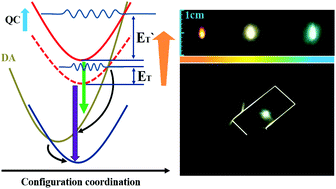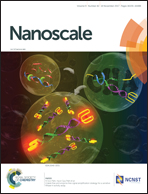Quantum confinement induced ultra-high intensity interfacial radiative recombination in nanolaminates†
Abstract
Al2O3/ZnO, Al2O3/TiO2, TiO2/ZnO and MgO/ZnO nanolaminates (NLs) were prepared using atomic layer deposition to explore the dependence of luminescence characterization on the sublayer width and constituents. When the ZnO sublayer width is larger than the Bohr radius in Al2O3/ZnO NLs, the UV luminescence arising from ZnO is reduced and even quenched with decreasing the ZnO width due to the nonradiative recombination (NR) caused by the existence of interface states, while for the ZnO width smaller than the Bohr radius, a visible luminescence rather than UV emission is observed and further enhanced with decreasing the ZnO width. It is also found that the visible luminescence needs a certain width of Al2O3 and is extinguished by the replacement of Al2O3 with TiO2. A theoretical model based on the configuration coordination and quantum confinement effect is proposed to understand the physical origin underlying the intriguing optical behaviour. The mechanism has generality and is applicable for other NLs as well, such as Al2O3/TiO2 and MgO/ZnO NLs with ultra-thin sublayers in which similar luminescence enhancements are also observed. This work may provide a promising approach for realizing high performance luminescence with various wavelengths for electro- and photo-luminescence applications in NLs.



 Please wait while we load your content...
Please wait while we load your content...